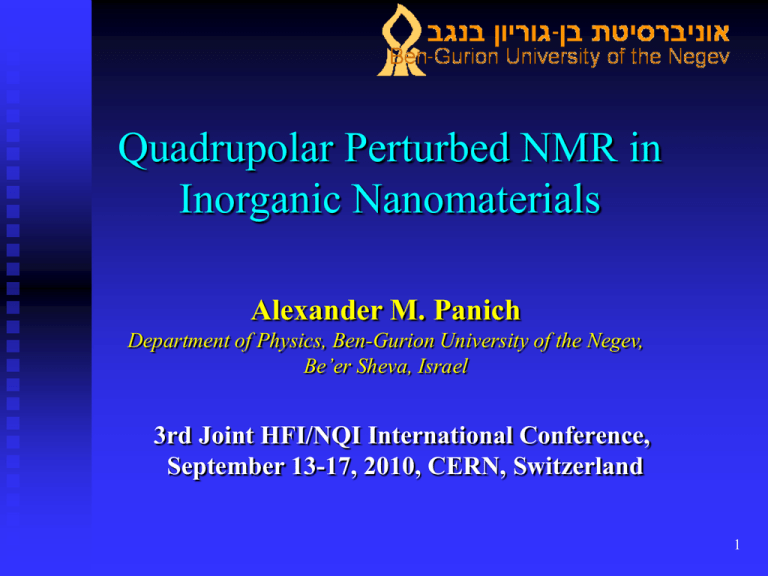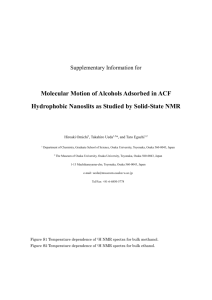Phase Transitions and Incommensurability in the - Indico
advertisement

Quadrupolar Perturbed NMR in
Inorganic Nanomaterials
Alexander M. Panich
Department of Physics, Ben-Gurion University of the Negev,
Be’er Sheva, Israel
3rd Joint HFI/NQI International Conference,
September 13-17, 2010, CERN, Switzerland
1
Why inorganic nanomaterials?
A lot of investigations of carbon nanostructures. Their properties
have been studied in detail.
In contrast, our knowledge of the physical properties of inorganic
nanotubes and fullerene-like species is still limited.
Eventual applications in electronics, magnetic recording, as nano-bio
materials, are used as low-friction materials.
NMR is an excellent tool in studying the local structure, electronic
structure and chemical bonding in inorganic nanoparticles.
Inorganic nanoparticles often contain atoms with quadrupolar nuclei,
such as 11B, 14N, 51V, 95,97Mo, etc. that nicely suit the topics of the
HFI/NQI Conference.
2
Carbon nanotubes and fullerenes
Graphite and graphene are semimetals. Solid C60 is a semiconductor.
Properties of carbon nanotube (CNT) vary from metallic to
semiconductor behavior depending on wrapping angle.
Solid C60 is a semiconductor
with energy gap 1.5–1.9 eV.
3
Inorganic nanotubes
Similar to CNTs, layered inorganic
compounds, such as BN, MoS2, etc. can
also form fullerene-like and tubular
nanostructures.
Crystal lattice of
hexagonal boron nitride (left)
and graphite (right)
However, they do not show such variation
of physical properties as CNTs do.
Similar to bulk samples, BNNTs are
semiconductors with a wide energy gap
5.5 eV irrespective of diameter and
chirality. Boron nitride fullerenes are
wide-gap semiconductors as well. MoS2
fullerenes seem to hold the properties of
bulk MoS2.
Why?
NMR study of electronic properties of inorganic nanomaterials.
4
Outline
NMR investigation of
- boron nitride nanotubes,
- molybdenum sulfide fullerenes,
- dithallium selenide nanorods
- vanadium oxide nanotubes
- Comparison of the data for bulk and nano-sized samples helps to
understand properties of the nano-sized compounds.
5
Boron nitride nanotubes
Crystal lattice of hexagonal
boron nitride
Tubular BN
6
First NMR study of BNNTs
Interpretation of 11B NMR spectrum: two
components arising from BNNTs with
different structures (hexagonal and
rhombohedral phases) showing different
chemical shift.
But! But! If so, splitting should increase
with increasing magnetic field.
In experiment - just in opposite!
11B
NMR spectra of BNNTs in
magnetic fields of 4.7 T and 14.1 T
(Jung et al, Solid State Commun.,
2004).
Quadrupole splitting?
7
Our study of multiwall boron nitride
nanotubes
SEM and TEM images of our
multiwall BN nanotubes.
Averaged inner diameter ~ 7 nm,
length about 1–2 mm, ~20 walls.
8
Our NMR study of BNNTs
11B
(I=3/2) – quadrupole nucleus
e 2 qQ
H n B0 I z
(3I z2 I 2 ) H dip H cs
4 I (2 I 1)
Hz>>HQ- the quadrupole interaction is a perturbation to the Zeeman term.
I = 3 /2 - the NMR spectrum consists of 3 transitions.
Central 1/2→−1/2 transition is not affected by the first order effects and is
observed at the Larmor frequency,
Satellites 3/2→1/2 and −1/2→−3/2 are shifted to frequencies determined by the
product nQ×(3cos2q-1)/2, where nQ=e2qQ/2h. In a powder, the satellite lines are
distributed over the frequency range of the order of 2nQ with the singularities at
±nQ/2 and shoulders at ± nQ and are hardly detected.
Hdip ,HCS << HQ; CSA(11B) ~ 27-40 ppm in h-BN and BNNTs
9
Room temperature 11B NMR spectrum
(A. M. Panich et al., Phys. Rev. B, 2006)
Room-temperature experimental 11B NMR
spectrum.
From the splitting between
satellites, D=nQ = e2qQ/2h the
values of nQ = 1.453 MHz and
quadrupole coupling constant
e2qQ/h = 2.906 MHz were
found.
Room temperature 11B NMR spectrum in magnetic
field B0=8.0196 T. In inset, separately measured lowfrequency satellite is shown.
Neither a splitting nor any unexpected
broadening of the satellite transitions was
observed, leading to the conclusion of a zero
value of the asymmetry parameter h.
10
Central (1/2→-1/2) transition
nL=109.538 MHz
The shape of the central transition is
determined by the second-order
quadrupolar effects. For I=3/2, line
shape in powder sample exhibits two
singularities with splitting
-40
-20
0
20
40
Frequency / kHz
D = 25nQ2/48n0
The separation between two peaks,
observed at n0=16.7 MHz, is 63.5 kHz,
yielding nQ=1.427 MHz and
e2qQ/h=2.854 MHz.
nL=16.704 MHz
No doubts - quadrupolar splitting.
-150
-100
-50
0
50
100
150
Frequency (kHz)
11
Temperature dependence of nQ
Increase in nQ with decreasing
temperature is mainly caused by freezing
of the low-frequency torsional librations
of a molecule as a whole that are large
for molecular crystals but are small for
the bulk h-BN and long multiwall
BNNTs.
Therefore the lattice dynamics of BN are
mainly due to zero-point vibrations.
Temperature dependence of the quadrupole
Frequency in BNNTs.
The quadrupole frequency in h-BN, measured at 4.2 K by SQUID, was
found to be 1.467 kHz – close to that RT that confirms weak
temperature dependence of nQ in h-BN.
12
Spin-lattice relaxation
measurement (n0=109.58 MHz)
11B
magnetization recovery in the
linear and semi-logarithmic scales may
be fit as a superposition of two
exponentials with very long 11B spinlattice relaxation times
T11= 76 ± 13 s, and T12 = 495 ± 21 s.
How to explain?
13
EPR
EPR signal: 10 well-resolved lines
due to unpaired electron trapped in a
nitrogen vacancy, which is
surrounded by m=3 equivalent boron
atoms.
B
e-
B
B
Number of hyperfine components is
N = 2×I×m + 1 = 10,
where I(11B)=3/2.
Density of PM centers determined by EPR, 9×1015 spin/g, is less than the
estimated number of the nanotubes in our sample, thus there are nanotubes either
with or without paramagnetic centers.
Two exponentials may correspond to NTs with and without paramagnetic centers.
14
Quadrupole coupling constants of bulk h-BN
and BN nanotubes at ambient temperature
Compound
e2qQ/h, MHz
Reference
Bulk h-BN
2.96 ± 0.10
[25]
Bulk h-BN
2.9
[26]
Bulk h-BN
3.00 ± 0.10
[23]
Bulk h-BN
2.936 ± 0.020
[27]
Bulk h-BN
3.2
[28]
BN nanotubes
2.880 ±0.026
Our data
23. M. Fanciulli, M. Corti, Phys. Rev. B 52, 11872 (1995).
25. A. H. Silver, P. J. Bray, J. Chem. Phys. 32, 288 (1960).
26. P.S. Marchetti, D. Kwon, W.R. Schmidt, L.V. Interrante, G.E. Maciel, Chem. Mater. 3,
482 (1991).
27. G. Jeschke, W. Hoffbauer, M. Jansen, Solid State Nucl. Magn. Reson. 12, 1 (1998).
28. K. Kanehashi, K. Saito, J. Molec. Struct. 602-603, 105 (2002).
15
Discussion
Closeness of QCC of the MW BNNTs and bulk h-BN reflects:
similar chemical bonding,
similar charge distribution over B-N bond,
and similar local symmetry.
These findings should result in similar electronic properties.
That is why BN nanotubes are semiconductors with a nearly constant
energy gap of 5.5 eV regardless of diameter, chirality, number of
walls of the tube, and this gap is close to that of bulk h-BN
(experiment: ~5.8 eV, calculations: 5.4-5.5 eV).
16
Discussion (continued)
Perhaps only BNNTs with very
small diameter would show
different electronic properties with
respect to those of bulk h-BN and a
decrease of the band gap caused by
the curvature of the sheets and
appearance of some sp2→sp3 rehybridization.
Energy gaps of BN nanotubes vs radius
(H.J. Xiang et al, Phys. Rev. B, 2003)
17
Bond length of the BN nanotubes as a function
of diameter. Solid line - bond length of h-BN.
(Moon et al, Physica E, 2004)
Bond lengths of BN-NT’s as a function of tube radius.
Yellow line - bond length in h-BN, 1.446 Å
(Akdim et al, Phys. Rev. B, 2003).
Calculations: B-N bond length in nanotubes is 1.438 Å, almost equal to the experimental value
in bulk h-BN 1.446 Å. Very small variations in the bond length with tube radius, except for
BNNTs with very small diameter.
Our BNNTs: average inner diameter ~ 7 nm, length about 1–2 mm, ~ 20 walls ranging from 8
to 40 layers.
18
Inorganic Fullerenes (IF) MoS2
2H-MoS2: triple S–Mo–S layers
bound by van der Waals forces Armchair (top) and
zigzag (bottom)
MoS2 nanotube
(Seifert et al.,
PRL, 2000)
TEM image of IF-MoS2 particle.
A polyhedral onion-like structure,
size ~ 40 nm, 20–30 MoS2 layers,
interlayer distance of 0.62 nm as
in bulk 2H-MoS2.
19
First 95Mo NMR study of IF-MoS2
and, for comparison, of bulk 2H-MoS2 sample
(Panich et al, J. Phys. Condensed Matter, 2009)
(15.7%) and 97Mo (9.5%), I = 5/2 – quadrupole nuclei.
Low natural abundance,
low resonance frequency (22.2 MHz in B0 = 8 T),
broad spectra due to quadrupole coupling and
very long spin–lattice relaxation time in nonmetallic specimens,
make measurements of Mo NMR spectra in powders difficult.
95Mo
Only a few Mo NMR measurements in solids, some of them - using 95Mo
enriched samples.
T.G. Bastow: 95Mo NMR of bulk 2H-MoS2 with natural abundance of the 95Mo.
Was in two minds, whether line shape is caused by second-order quadrupole
interaction, by chemical shielding anisotropy, or by both these effects.
20
For the axially symmetric electric field gradient (h = 0) caused by the axial
(threefold) symmetry of the Mo site, the second order shift of the central component
is
n Q2
1
1
3
n ( ) (
)[ I ( I 1) ](1 m 2 )( 9 m 2 1)
2
2
16n 0
4
m= cosq, where q is the angle between the principal axis of the electric field
gradient and the applied magnetic field, and n0 is the Larmor frequency.
Spacing between the two peaks is
25n Q2
3
D n 1 n 2
[ I ( I 1) ]
144n 0
4
For I =5/2
3 e 2 qQ
nQ (
)
20 h
D
25n Q2
18n 0
21
Normalized spectrum intensity
1.0
IF-MoS2
95
0.8
Experimental room temperature 95Mo NMR
spectra of bulk 2H-MoS2 (bottom) and IF-MoS2
(top) samples and the simulated spectra (blue
lines).
Mo,
n0=22.217 MHz
Na2MoO4
0.6
0.4
Our measurements in B0 = 8 T reveal nearly the
same splitting D = 41.2 and 41.6 kHz for IF and
bulk samples, respectively.
0.2
0.0
-100
-50
0
50
100
Normalized spectrum intensity
Frequency (kHz)
Bastow, bulk 2H-MoS2, 9.4 T, 26.06 MHz :
D = 42.7 kHz. Since quadrupolar splitting
D ~ 1/n0, smaller D ~ 35 kHz is expected.
1.0
bulk 2H-MoS2
95
0.8
Mo,
n0=22.217 MHz
The only way to reconcile our data with those of
Bastow is to take into account a contribution of
chemical shielding anisotropy to the NMR line
shape for powder samples, which may be
essential for heavy nuclei such as 95Mo.
Na2MoO4
0.6
0.4
0.2
0.0
-100
-50
0
50
100
Frequency (kHz)
22
For the axially symmetric shielding tensor, this contribution is described by the expression
n n 0 [1 (3m 2 1)]
Combined nuclear quadrupole and anisotropic chemical shift effects in a single crystal result
in the following expression for the central transition
n
1
1
3
n ( ) n 0 {1 ( Q )[ I ( I 1) ](1 m 2 )( 9 m 2 1) (3m 2 1)}
2
2
16n 0
4
2
In a powder, the line shape possesses two singularities and a step, with splitting between the
maxima
2
2n 03 25n Q 5
2n 03
25b 5
D n 2 n1
n 0
n 0
9n 0 3
4b
18n 0 3
2n Q2
b
n Q2
3
[ I ( I 1) ]
16
4
23
r
n 02
b
//
3
our case
Abscissa, (n-n0), in units
Jones W.H., Graham T.P. and Barnes R.G., Phys. Rev. 132 1898 (1963)
n Q2
n 0 2n 0
b
24
IF-MoS2
95
0.8
Mo,
Normalized spectrum intensity
Normalized spectrum intensity
1.0
Na2MoO4
n0=22.217 MHz
0.6
0.4
0.2
0.0
nQ
nQ
-100
-50
0
50
100
95Mo
spectra
simulation using
DMfit2009
software
1.0
bulk 2H-MoS2
95
0.8
Mo,
n0=22.217 MHz
Na2MoO4
0.6
0.4
0.2
0.0
-100
-50
0
50
100
Frequency (kHz)
Frequency (kHz)
(D. Massiot et al.,
Magn. Reson.
Chem. 40 70
(2002)).
r~-1.47
Compound
nQ
, kHz
MoS2 nano 578 ± 15
MoS2 bulk
565 ± 25
D = (// - ), kHz
D = (// - ), ppm
3.85 ± 0.1
- 33.53
- 1510 ± 80
3.77 ± 0.16
- 32.6
- 1470 ± 100
e 2 qQ
h
, MHz
NMR parameters for bulk and nanoparticles are close to each other.
25
Discussion
1. MoS2 nanoparticles exhibit QCC and CSA similar to that in bulk compound,
reflecting similar local crystal structure, local symmetry, chemical bonding, and
charge distribution over the Mo–S bond in bulk and IF samples. This fact results in
similar electronic properties of these materials.
It seems that Mo–S bonds are strong enough to hold Mo–S and Mo–Mo distances
and are little affected by weak curvature of the layers. Perhaps only single-wall IFs
with very small diameter and large curvature would show different electronic
properties compared to those of bulk. Multiwall –> close to bulk.
Is there any
difference between
bulk and nano?
26
95Mo
Spin–lattice relaxation measurements:
very long spin–lattice relaxation times T1 ~ 255 s and 122 s for bulk MoS2 and IFMoS2, respectively. Reduced T1 in IF-MoS2 compared with that in bulk sample is
attributed to larger density of paramagnetic defects and to interaction of nuclear
spins with electron spins of these defects, which gives rise to effective spin-lattice
relaxation channel. This is confirmed by
EPR measurements: N = 1.9 × 1016 spin/g for bulk 2H-MoS2
and N = 1.16 × 1017 spin/g for IF-MoS2.
MoS2-IF have more defective structure than the bulk
sample.
Nearly defect-free MoS2 flat faces with a limited number of
defects at the edges of polyhedral nanoparticles appearing upon
folding of the triple MoS2 sheets, when some atoms are left
unbound and form defects with dangling bonds. Such defects
arise from the difficulty in formation a perfect polyhedral
structure by the folding of triple MoS2 layers.
27
Attempt to observe an NMR signal from the 97Mo isotope
Since the quadrupole moment eQ of 97Mo is 11.5 times larger than
that of 95Mo and since the relaxation time T1 is proportional to
(eQ)−2, one can expect a much shorter T1 for 97Mo which could be of
a great advantage in the present experiments.
However, the linewidth of the central transition caused by secondorder quadrupolar interaction varies as (eQ)2 and thus should yield a
linewidth of the order of 5.5 MHz.
Therefore the 97Mo NMR signal was not detected.
28
Conclusion on BNNTs and MoS2-IFs
Multiwall BN nanotubes and multishell inorganic fullerenes
MoS2 exhibit QCC and CSA similar to those in the bulk
compounds, reflecting similar local crystal structure,
chemical bonding, and charge distribution over the B-N and
Mo–S bonds in bulk and nano-materials.
These findings result in similar electronic properties of the
corresponding bulk and nano-materials.
29
Tl2Se: properties of inorganic nanomaterial
differ from those of bulk samples
Comparative NMR study of bulk and nanorod
samples of Tl2Se
The average size of Tl2Se nanorods is about 75 nm in diameter
and 900 nm in length.
(A. M. Panich, M. Shao, C. L. Teske, W. Bensch, Phys. Rev. B, 2006)
30
T= 291 K
B0=8.0196 T
NMR signal (arb. units)
196.5
Tl2Se nanorods show a regular chemical shift,
bulk Tl2Se exhibits Knight shift characteristic of
conductors, which originates from the hyperfine
interaction between nuclear spins and conduction
electrons.
Tl2Se nanorods
K
| (0) | EF
2
s
e
Tl2Se bulk
197.0
197.5
198.0
198.5
199.0
Frequency (MHz)
205Tl
8
3
NMR spectra of bulk and nanorod Tl2Se
samples at T=291 K and B0=8.0196 T.
However, Knight shift in bulk Tl2Se (0.3%) is
much smaller than that in Tl metal (1.6% of
the Larmor frequency).
Such value is characteristic of a semimetal
showing reduced density of states (DOS) at the
Fermi level.
Spin-lattice relaxation: Korringa term in Tl2Se, 1/T1T = 1.2 s-1K-1,
is much smaller than that of Tl metal, 1/T1T ≈ 330 s-1K-1, indicating
much smaller DOS at the Fermi level of Tl2Se in comparison with
that in metallic thallium; such value is characteristic of semimetals.
31
Tl2Se nanorods are semiconductors and
exhibit a characteristic activation behavior
in the spin-lattice relaxation rate due to
the thermal excitation of carriers to the
conduction band. The activation energy
was determined to be DE =0.24 eV.
0.025
-1
T1 (ms )
0.020
-1
0.015
0.010
0.005
0.000
50
100
150
200
250
300
T (K)
Temperature dependence of 205Tl spin-lattice
relaxation rate of Tl2Se nanorod sample in
B0=8.0196 T. Exponential fit is shown by
dotted line.
32
1000
Semimetal
500
Energy
Conduction band
0
Fermi level
Valence band
-500
-1000
-30
-20
-10
0
10
20
30
In semimetal conduction and valence
bands touch each other. Such band
structure is sensitive to different effects,
which may cause gap opening. Size
reduction can significantly change the
properties of the compound.
1000
Wide band semiconductor
Energy
500
Analogous bulk-to-nano transformation
of insulators and wide gap
semiconductors does not show visible
changes in their properties.
Conduction band
Fermi level
0
Valence band
-500
-1000
-30
-20
-10
0
10
20
30
33
Vanadium oxide nanotubes
Vanadium oxides often crystallize as layered compounds. They may be diamagnetic,
paramagnetic, ferromagnetic, show metal-insulator transition, superconductivity, etc.
VOxNTs are of interest due to their application in spintronics, which requires
fabrication of magnetic nano-structures.
Structure of VOxNTs is composed of
scrolled V7O16 layers between which
alkylamine molecules (acting as the
structure-directing agents) are
embedded.
They are considered to be of mixed
valence containing V4+ and V5+ ions,
which would be seen in the NMR
spectra.
VOx
alkylamine
TEM image of the VOx nanotube
34
VOx-decylamine nanotubes
[CH3(CH2)9NH2]-VOxNT or C10-VOxNT
VOICl3 at 89.75 MHz
Normalized spectrum amplitude
1.0
51V
NMR spectrum: 3 peaks at
~89.73 MHz, ~89.93 MHz and ~90.06 MHz.
0.8
0.6
Position of the low frequency line is close to
that of diamagnetic VOCl3 and is attributed
to diamagnetic V5+ ions.
51
V NMR
in VOx-NTs
0.4
0.2
0.0
88.5
89.0
89.5
90.0
90.5
Frequency, MHz
Room temperature 51V NMR
spectrum of VOx nanotubes.
Arrow shows position of VOCl3
reference.
91.0
High frequency resonances reveal a
"paramagnetic" shift of 200 - 300 kHz and
are assigned to two inequivalent
paramagnetic V4+ ions.
The ratio of the intensities Id/(Ip1+Ip2) ~ 2.13,
which yields a rough estimation of 68% of
V5+ and 32% of V4+ ions.
35
450
12
51
V in VOxNTs
low frequency line
10
T1, ms
400
R1, ms
-1
350
high frequency line
300
Quadrupole contribution to NSLR results from
modulation of quadrupole interaction by lattice
vibrations, yielding temperature dependence
b
and R1Q ~ T 7
R ~ T 2 (a
)
8
6
high frequency line
4
2
250
low frequency line
50
100
150
200
250
300
1Q
T, K
200
150
100
4
6
8
10
12
Two main contributions to spin-lattice the
relaxation (NSLR):
14
-1
1000/T, K
T2
for low and high temperatures, respectively.
Increase in T1 on cooling in the high
temperature region is attributed to the
quadrupole contribution to the NSLR.
Temperature dependence of 51V spin-lattice
relaxation time in VO-NTs
Magnetic contribution to NSLR due to coupling of nuclear spins with electron spins of the
e
paramagnetic ions m
0 - NMR frequency, e - electron correlation time.
R1 ~
2 2
e~10-9-10-12 s, 0e<<1 and R1~e0exp(E/kBT)
1 0 e
T1m decreases on cooling, which explains our experimental data in the low temperature
region.
The interplay of paramagnetic and quadrupolar contributions yields T1(T) dependence
observed in the experiment.
36
Summary on VOxNTs
Our NMR study of the multiwall vanadium oxide decylamine nanotubes reveals diamagnetic V5+ and two
paramagnetic V4+ ions, respectively. The amount of the V4+
ions was estimated as ~32% from the line intensities of the
NMR spectra.
51V
spin-lattice relaxation data comprise both magnetic and
quadrupolar contributions.
37
Collaboration :
Crystal growth and characterization:
C. C. Tang, National Institute for Materials Science, Tsukuba, Japan
R. Rosentsveig and R. Tenne, Weizmann Institute for Science, Rehovot, Israel
Cheol Eui Lee, Department of Physics and Institute for Nano Science, Korea
University, Seoul, Korea
C. L. Teske and W. Bensch, Christian-Albrechts University, Kiel, Germany
38
39
Semimetal-semiconductor transformation on reduced
size due to quantum confinement
Metal particle: quantum confinement is observed when the size is reduced to a
value corresponding to the de Broglie wavelength; the density of states in the
valence and conduction bands decreases, causing metal-nonmetal transition.
Metals: de Broglie wavelength of the carriers is of the order of the lattice spacing.
Thus quantum confinement is visible only for very small particles.
Semimetals and semiconductors: de Broglie wavelength may exceed the lattice
spacing by several orders of magnitude, thus quantum confinement may be
observed for rather large nanoparticles, i.e. for Tl2Se nanorods with diameter of 75
nm and length of 900 nm.
Another example: semimetal Bi exhibits quantum confinement effects at a film
thickness of ~100 nm. Bi nanowires show semimetal-semiconductor transition as
the wire diameter is reduced down to 250 nm (Dresselhaus et al, Farhangfar).
Semiconductors show an increased band gap with reduction of size due to
quantum mechanical effects.
40
Metals: Korringa relation that arises from the
interaction of nuclear spins with conduction
electrons
0.5
-1
T1 (ms )
1
4k n 2 2
( ) K const
T1T
e
Tl2Se bulk
0.4
-1
0.3
0.2
0.1
50
100
150
200
250
300
T(K)
Temperature dependence of 205Tl spin-lattice
relaxation rate of Tl2Se bulk sample in B0=8.0196
T. Linear fit at low temperatures is shown by
dotted line.
In bulk Tl2Se, the Korringa-like spin-lattice
relaxation behavior is observed at low
temperatures and is transformed to an
activation regime above ~200 K.
Interpretation: two-band model in the
semimetallic compound, in which one band
touches the Fermi level, while the second band
is separated from the Fermi level by an energy
gap DE. In this case, the relaxation rate is
given by the expression
1
1
DE
CT exp(
)
T1 T1K
2k B T
DE = 0.16 eV.
Normally, the spin contribution to 1/T1KT is proportional to the DOS at the Fermilevel. From linear fit of the data below 200 K, we obtained 1/T1KT = 1.2 s-1K-1, that
is much smaller than that of Tl metal, 1/T1T ≈ 330 s-1K-1. The obtained value of
1/T1T indicates much smaller DOS at the Fermi level of Tl2Se in comparison with
that in metallic thallium; such value is characteristic of semimetals.
41




